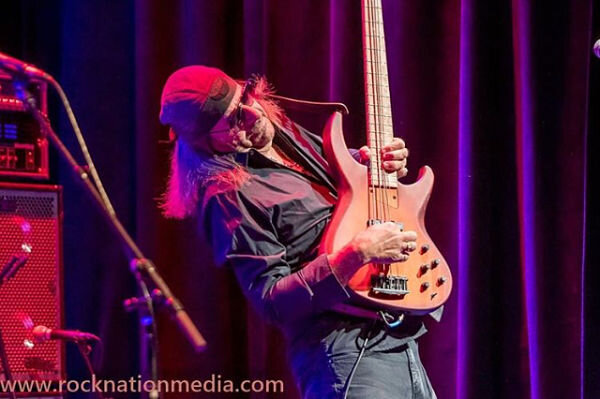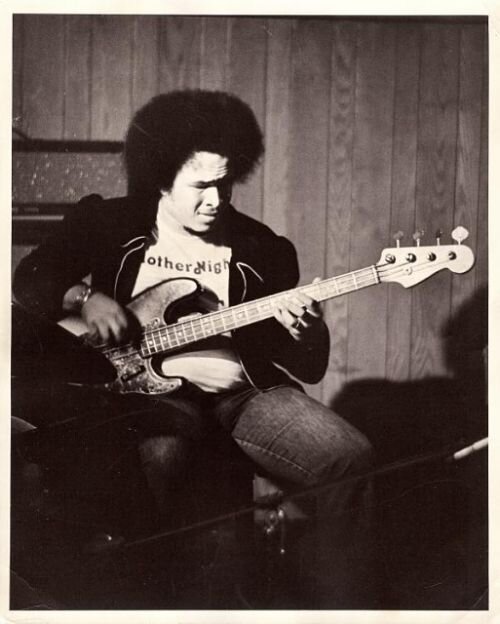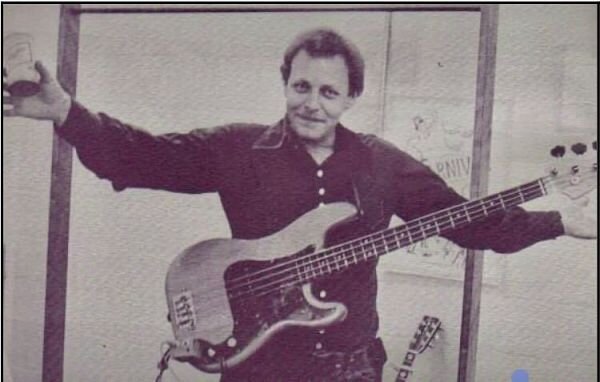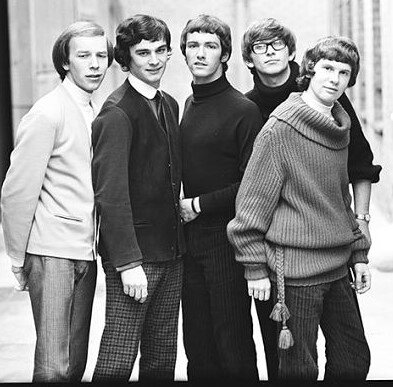Pete Bremy (Cactus / Vanilla Fudge)


By Joe Gagliardo
The American Dream—you flip out after seeing the Vanilla Fudge at the age of fourteen; play a bunch of their songs in a band; retire from the music business for twenty years; and then years later, go from being an Assistant Webmaster of a Vanilla Fudge fan site to being the bass player in the Vanilla Fudge and Cactus. Only in America!
Pete grew up in a house filled with music. His mom played piano (though they didn’t have one in the house), and his dad tinkered with a 1949 Hammond Spinet organ. His dad also owned and operated an electronics company that built stereos and TVs. That meant a lot of demonstration records were in the house, and his dad was always spinning records – from classical to jazz. Pete had his own cool collection of 45s, including “Bad Boy” by the Jive Bombers.
In 1962, when Pete was nine or ten years old, he was a percussionist in his grammar school concert band. Many bass players picked up the bass after seeing Paul and The Beatles, but Pete picked up drumsticks instead, after seeing Ringo. Pete banged on a practice pad and furniture, until he cobbled together a drum set. By his freshman year of high school, his parents bought him a set of Ludwig Black Diamond Pearl drums, which he still owns. He studied music theory in high school, and attended William Patterson University for two years studying percussion, where he studied with Thad Jones.
Like many kids at the time, having friends play music in his basement worked well, but once his bandmates decided they wanted to jam at other houses, pulling the drums on a wagon was not a viable alternative, so Pete volunteered to play guitar. One day, his best friend said to Pete “we have enough guitars—play bass! It only has 4 strings, and you only have to play one low note at a time.” Pete thought that would be cool, but after developing into a pretty good drummer, he quickly grew bored playing roots and fifths. That was soon about to change.
When Pete was fourteen, a musician friend who was a year older, and always on the cutting edge of new music, took him to an outdoor concert in New Jersey to see a band called the Vanilla Fudge. It was August, 1967, the day before the Fudge’s debut LP was released. Although the band had released the 45 “You Keep Me Hanging On,” Pete had not heard it. Seeing the Fudge and hearing Tim Bogert changed his life that day. Tim’s lines were innovative, and he played with speed and muscle. To this day, Tim is one of the fastest bass players Pete has ever seen, even if he is sometimes only playing with one finger. The bass was no longer boring!
In addition to igniting his interest in the bass guitar, Pete immersed himself in the music of the Vanilla Fudge, even learning the keyboard parts on his dad’s Hammond Spinet. There came a point when Pete could play the entire Vanilla Fudge album on bass, organ and drums!
When Pete was part of a cover band, Heaven’s Sundae, they became popular playing the teen clubs, CYO events, and school dances. Because their repertoire included a heavy dose of Fudge music, they were often referred to as the Heaven’s Vanilla Fudge Sundae.
After playing the New Jersey music circuit for several years, Pete retired from music for about twenty years. During that time, he worked in the printing industry, married and raised a family, became a volunteer firefighter, and became a volunteer search and rescue dog handler.


You must be wondering–how did Pete get pulled back into music?
Well, his bass playing neighbor signed up for a gig around Christmas, 1993 playing cover tunes, and when he realized he didn’t know most of the songs, and it was only a few days away from the gig, he asked Pete to share the gig with him as a favor. The neighbor didn’t care that Pete hadn’t played for twenty years, and Pete did the gig, playing two of the three sets. That ignited the “bug” in him, and he started going to weekly jam nights, just to listen. Ultimately, the bass player of the house band found out Pete played bass, and got him up on the bandstand.
When Pete was in his early forties he was looking to get a part-time job, and his wife suggested that he start playing music again. He reunited with his childhood friend who originally encouraged him to play bass, and they started gigging together. During the entire time, whether he was playing music, or in retirement from music, he continued to follow the members of the Fudge in their various projects.
Over the years, some of the bassists Pete has loved listening to include Tim Bogert, Paul McCartney, Chris Squire and John Entwistle.


In March, 1997, on a night he couldn’t sleep, he went to his computer, rather than turn on the TV, and, by chance, punched in Vanilla Fudge. A fan web site popped up that had only been in existence for a few months, and he started communicating with the Administrator.
Since Pete had some familiarity with websites, he became the Assistant Administrator. At this point in time, the Fudge was not together, the Fudge members had no affiliation with the site, and Pete had no contact with members of the Fudge. Over time, each member found the site, and the Administrator convinced the band to make it their official website, and that’s what happened.
One of the first official steps taken by the official site was to interview Vince Martell. When Pete saw the interview, which was done outdoors, he realized that he and Vince lived in the same area. Although Pete had no contact with Vince Martell, one of Vince’s friends contacted Pete through the website to talk about the band. Pete gave him his contact information, and asked him to pass it on to Vince.
Months later, Pete received a call from Vince, who was impressed Pete knew so much about the Fudge. Pete asked Vince to let him know when he would be playing, and Pete ended up going to see Vince play an acoustic show at a coffee house. When Pete asked Vince to play the song “Thoughts”, from the Renaissance LP, a song Vince wrote, they hit it off, had a lengthy conversation, and became friends.
Weeks later, Vince was telling Pete that he had an acoustic duo gig that night, but the bass player dropped out at the last minute. When Pete offered to fill in, Vince was surprised, because Pete had never mentioned that he was a musician. Pete filled in, and that further solidified their friendship, and led to Pete joining the Vince Martell Band in 2000.
In 2002, the Vanilla Fudge consisted of Vince on guitar, Tim Bogert on bass, Carmine Appice on drums, and Bill Pascali on keys. The band had three gigs lined up for a Friday, Saturday and Monday–at the Stone Pony in Asbury Park, NJ, a club in Virginia, and BB Kings in NYC. Pete and his wife had decided to take a mini vacation, and catch the band at each of the three stops. To his surprise, he received a call from Carmine on Thursday, at 4:15 pm, saying Tim had suddenly taken ill. Vince had told the band Pete knew all of the material, and Carmine asked if Pete would be able to sub. Thursday night at 10 PM, they did a quick run through the set at Pete’s house, and Pete did all three dates, playing bass and singing Tim’s harmony parts. That subbing went on for the next six months, including tours of Sweden, Denmark and California.
Pete’s playing with the band ended when his vacation time ran out at his day job, and he was replaced by T.M. Stevens. Pete was so upset that he quit his job in the printing industry, and acquired a real estate license, so he could play music and make his own hours at work.
In 2004 and 2005, Pete toured with Essra Mohawk, whose Primordial Lovers album was rated by Rolling Stone as one of the 25 top albums of all time. Essra is also known for her songwriting, including “Change of Heart” by Cyndi Lauper, and “Stronger Than the Wind” by Tina Turner, and she played for a period with Frank Zappa and the Mothers of Invention, and assumed the moniker “Uncle Meat.”
In 2005, the original Fudge members reunited, now including Mark Stein on keys. Tim Bogert asked Pete to be his bass tech, and Pete also became the band’s road manager during 2005-2006.
Tim Bogert retired from playing in 2008, and in 2010, Carmine booked the Fudge for a gig at BB Kings in NYC. At that point, 10 years after the odyssey began with joining the Vince Martell Band, Pete became the bass player for the Vanilla Fudge, and remains there today.
Prior to Pete’s joining the Fudge full-time in 2010, Carmine, had reformed Cactus with Tim Bogert and Jim McCarty. Tim retired shortly thereafter, and another bass player was brought in. When that bassist couldn’t make a gig, Pete was called in, and ended up being with Cactus for the next five years.


Pete has multiple releases with all these bands, including solo albums with Vince Martell, and live and studio albums with Vanilla Fudge and Cactus. He has also played a number of memorable gigs with these bands, including the Fudge on the Jimmy Fallon Show; the Fudge headlining the Suwalki Blues Festival in Poland in front of 10,000 fans; and Cactus appearing with Govt. Mule at a blues fest in Germany.
Pete’s original go-to bass was a ’66 Hagstrom II bass, which he hot-rodded by adding a Gibson Humbucker pickup, and he wired it in stereo so that it could run through a Marshall stack and a Standell Super Artist. In 1974, he purchased a “74 Fender Jazz bass, that he played regularly until 2007. In 2007, he bought a Washburn 6 string, that became his go-to bass, tuned BEADGB.
In recent years, he has acquired a stash of Michael Tobias Design (“MTD”) basses, including a USA 635-24, a USA 5-string Saratoga, a Kingston KZ6 with Bartolini pickups, a 4-string Kingston CRB that he uses with Vanilla Fudge, and a Kingston 5-string Saratoga. For his rig, he uses Hartke HyDrive 4×10 and 1×15 cabinets with a HA 5000 head. He supplements his sound with a Boss Bass Chorus and a Boss Distortion pedal.
You can catch Pete and the Vanilla Fudge on tour, and you can check out Pete’s playing here:
Vanilla Fudge–“You Keep Me Hanging On” Live on Jimmy Fallon https://youtu.be/RuisGkFcDXI
Cactus—“Parchman Farm” Live in Tokyo https://youtu.be/_Sc6J3rPeMw




























